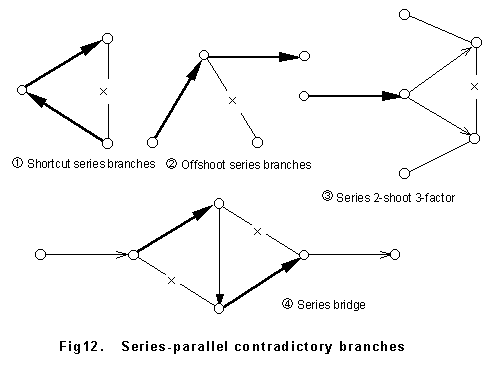Hamiltonial series-parallel reduction is such a procedure below.
2-4. Series-Parallel Experiment
Although
it is intuitively understood that a graph having parallel elements turns to be a
non-Hamiltonian graph, the concept of series-parallel homeomorphism cited in Graph Theory
cannot separate non-Hamiltonian graph from Hamiltonian graph, then we developed such
conversion method to judge Hamiltonial homeomorphism. As series branches are always to be
branches on determinative paths in Hamiltonian experimentation, it is necessary that the
attribute of being series branches must be preserved to be distinguished later. Here, we
introduce a peculiar branch having series branch attribute to satisfy this condition.
Hamiltonial series-parallel reduction is such a procedure below.
(1) Replace series branches with a determined branch of series branch attribute.
(2) Short-circuit other points than terminal points of determined branches.
(3) Repeat from (1) until there is no series branches or branches serial to determined
branches.
To
be short, serial-parallel reduction is a method to short-circuit all of 3 or more-factor
points and to examine 2-factor vectors on a graph. As it is possible to identify
determinative paths with determined branches, we may consider this experiment that it
extracts global relation among determinative paths on the way of experiments and a part of
graph not yet experimented. If a reduced graph obtained in such way is one of the case
bellow, the original graph is a non-Hamiltonian graph.
(1) series loop: There exists a circuit which is not a Hamiltonian tie.
(2) 3-parallel-series: There exist 3 determined branches share one point.
Series-parallel experiment is essentially a judgment with non-retrial
and it is able to separate both model of series loop and 3-parallel-series as
non-Hamiltonian graph. (1) is an offense against 1-circuit rule of Hamiltonian postulate
and (2) is an offense against 2-factor rule, and here is a possibility to detect earlier
by far than factor experiment become able to detect them. Moreover, series-parallel
experiment can detect contradictory branches or obstacle branches with respect to series
branches as by-products. Contradictory branches and obstacle branches to be removed by
series-parallel experiment are the followings.
(1)A branch parallel to determined branch or a branch conjoining 2 terminal points of
adjacent determined branches
(2)A branch connected to the joint point of adjacent determined branches
(3)A branch conjoining series 2-shoot 3-factor points (there exist 2 shoot branches at a
terminal point of a determined branch and end points of the 2 shoot branches are both
3-factor point, when the branch conjoin those points )
(4)Branches being 2 edges of a series bridge (a square figure comprising branches
conjoining 2 terminal points of 2 determined branches and a branch conjoining diagonal
points) , a branch conjoining diagonal points shall be auto-determined.
Among
them, we can manage (3) with 3-terminal division experiment and (4) can be disposed by
2-terminal experiment, therefore the others than (1) and (2) are not indispensable
functions. If we would feature such a kind of formulas in go-game in the experiments,
Hamiltonian experimentation should probably be something like a sure-victory program of
go-game. Owing to a reason to improve practical efficiency of experimental program, those
deviation might be admitted in some cases.

Although series-parallel experiment is a superior method with an
ability to detect offenses in an early stage, principally it has no efficiency for such
graphs as have 2-factor points at less than 2 places. Expand the series-parallel
experiment and admit that a branches list or a single branch on determinative paths may be
regard as a determined branch, an operation to determine a branch shall be reflected
directly to the series-parallel experiment.
And
also, we can suppose such a method as dispersing start points of determinative paths on
the graph and observing at 3 fixed points . In the case that 3 determined branches are
disposed on the graph dispersively, it is considered that a graph obtained by
series-parallel experiment comes to be one of the 6 kinds of primitive letter graphs
below. (Above 3 branches, still more primitive letters would be added. )

At the present time, a theorem to justify Hamiltonian series-parallel
experiment has not come to obtain it's proof yet. While to prove homeomorphic conversion
is generally difficult, this proof especially seems fairly hard. We are afraid that it
comes to be such involved one as a proof of 4-color-theorem problem.
Def.10 Hamiltonian series-parallel reduction, Hamiltonial series-parallel
We call the following graph conversion by Hamiltonian series-parallel reduction.
- Remove such points that branches number equal 2 and make one determined branch.
- Short-circuit adjacent points of more than 3 branches number except terminal points of determined branches.
- Repeat these operations. When there is no point to be disposed, open-cut every branches except determined branches.
- Next, Open-cut every determined branches not included in any circuits.
As
the result of this Hamiltonian series-parallel reduction with graph G, if the graph comes
to have a subgraph of isomorphic graph represented below, we say this graph is Hamiltonial
series-parallel.
a. a graph contains an isolate point as a proper subgraph.
b. 2-point 3-mult-branch graph (2 points graph having 3 parallel branches)
Theorem 4. Hamiltonial series-parallel graph
A Hamiltonial series-parallel graph is a non-Hamiltonian graph.
Proof.
Pending.